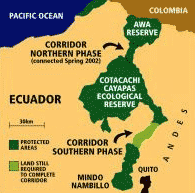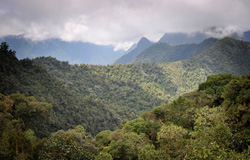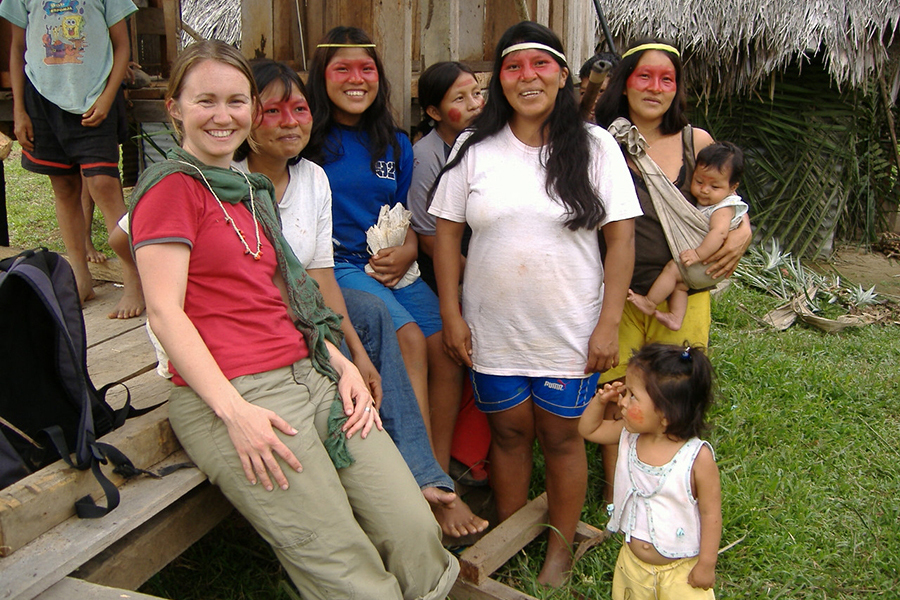Ecuador Cloud Forest

Choco-Andean rainforest corridor
Since 1994 our international project partner, UK-based Rainforest Concern, has made dramatic progress in buying back land to build a biodiversity corridor between the Andean Cloud Forests and the lowland forests of the Awa Ethnic Reserve.
The northern phase of the project, which was to connect the Awa Reserve with the Cotacachi Cayapas Ecological Reserve was completed in 2002. This was a significant achievement in international conservation with 30,000 acres bought back and protected.
Since 2004 Rainforest Rescue has been supporting the southern phase of the project; to connect the Choco-Darien Rainforest with the Andean Cloud Forests. This phase covers the widest range of habitats with altitudes stretching from 1000m to 3500m.
To date 1761 hectares have been protected.
The Cloud Forests are in grave danger from the constant threat of logging, mining and farming. As a habitat, they are home to an incredible range of animals including jaguars, spectacled bears and many rare birds, but the relentless pace and scale of destruction is edging these animals towards extinction.
Biological corridors are essential to maintain migration of animal and plant species from one area to another and to ensure healthy population levels.

Ecuador cloud forests & biodiversity
Ecuador’s size is only 276,880 km2, a little larger than the Australian state of Victoria, or about half the size of France.
Although relatively small in size, the Ecuador Cloud Forests are considered the single richest hotspot on the planet, containing approximately 15-17% of the world’s plant species and nearly 20% of its bird diversity.
While Ecuador covers only 1.6% of South America, it is home to almost 50% of the bird species on the continent (1,515 out of 3,100).
The dry and moist forests of western Ecuador are some of the most threatened ecosystems in the world. The arid region of south-western Ecuador harbours 55 restricted range bird species – the second highest total of 57 global “Endemic Bird Areas”.
With over 1,500 species of birds it ranks fourth in avian diversity amongst all countries in the world. By comparison the size of Australia is 7,617,930 km2 and has 800 species of birds.
Ecuador’s Cloud Forests are home to iconic species such as the Spectacled Bear, Jaguar, Sloth, Howler Monkey, puma and many other creatures.
Sadly Ecuador’s rainforests are being cleared at a rate of approximately 198,000 hectares per year including large areas of Cloud Forests. At this rate it is predicted that Ecuador will be completely deforested within the next 30 years.

Community engagement for rainforest protection
The Ecuador Save a Hectare Project is undertaken in partnership with our international project partner, UK-based Rainforest Concern.
Like the rainforest itself the strategy of the project is diverse. The purchase of rainforest alone is not sufficient in an economically disadvantaged country like Ecuador. Land is a resource with which people are intimately involved at a primary level. To ensure the Cloud Forests survive, economic alternatives are needed for local people to relieve their current dependence on unsustainable and destructive agriculture.
The project assists local people to develop small businesses in sustainable agriculture in low impact extractive industries like shade-grown coffee that is sold through a fair trade agreement and community industries that collect Tagua Palm nuts to create jewelry.
Through the creation of community owned eco-tourism, farming communities have willingly converted their farms into Cloud Forest reserves in exchange for the infrastructure that allows them to host tourists.
If land adjacent to the established eco-tourism reserves is offered for sale, then it can be purchased and added to the reserve. Local people can be employed as needed to manage and protect the Cloud Forests.
These initiatives ensure that protecting the Cloud Forests becomes part of the highly valued new economy.
This depends on each situation. In Ecuador we have mainly being buying from local farmers who have been clearing land for cattle or sugar cane. Much of the land bought for the Awacachi Corridor (the northern phase of Ecuador ‘Save a Hectare’) was bought in competition with African palm oil plantations. We always pay market rates or better and never put pressure on owners to sell – in fact it is often the owners who place pressure on us to buy. We occasionally buy land owned by large companies. We try to buy large blocks at the same time to avoid price escalation/expectations.
Increasingly we often buy land FOR rather than from local communities when they can be persuaded to protect the forest surrounding their farms. This is the case with our Watershed Protection project in the Choco-Andean Corridor in Ecuador where we have been purchasing the title of land for people who only occupy land who in return sign an undertaking to protect the forests and not allow their rivers to be polluted by fertilizers or cattle effluent.
We NEVER buy land from indigenous people but have helped to extend territory as with the Yawanawa in western Brazil.
Generally local communities or it will be put in the name of Rainforest Concern (UK) and a local NGO.
When land is not bought for local communities, it is either bought solely in the name of our partner NGO or jointly in the name of Rainforest Concern and a local NGO In a very few instances when land needs to be bought and protected urgently but there is no obvious NGO to buy it through, then we have bought it in Rainforest Concern’s name alone. It is important to note that we generally only purchase land when we can be very confident that the local NGO has the necessary experience/track record to protect and manage land in the long term. This is our paramount concern and we choose our partners very carefully indeed.
how exactly is the land protected?
Our local partner organisation generally employs rangers to patrol the land purchased and maintain trails.
Clearly there is a big difference in the level of protection required for a reserve close to a city and near a main road to that of a very remote and mountainous reserve. The former may require guard posts and regular, perhaps weekly, inspections whilst the later may require much less frequent inspections and the most effective method of protection may be a six monthly flyover to see if incursions have been made. Well maintained signs and trails are extremely important as is the need to demonstrate that the reserve is being used and looked after. When problems have been encountered (hunting, squatting, farming/settling) then this has usually been as a result of lack of activity and people assuming the land is “up for grabs”.
There is always a written ‘inter-institutional” agreement between us and of partners setting out the responsibilities of each organisation and to each other.
Land purchase is just one element of our work and these agreements cover not only protection for the land purchased/managed but also alternative income projects, education, eco-tourism, communication with local/national government and scientific research. Most importantly the agreement sets down the reporting procedure, frequency of reports and who should write them. It will define how much control is required on the project funding, accounting and receipts required for services/items. Funding for projects is done in phases and we rarely release funds for a new phase before we have approved the report for the previous phase. Our partner organisations are sometimes also required to sign a written undertaking for the management of a particular block of land purchased for conservation. This may include the frequency of patrolling, construction of buildings (e.g. lodge); density of trails, eco-tourism use, if a former owner/occupier may continue living on the land and so on.
By virtue of the fact that most of the world’s remaining forests exist in politically unstable countries there is always a risk that this could adversely affect our work. However in practice this has seldom been a problem. The most worrying scenario would be the expropriation and nationalisation of land but as most countries seem to go from one right wing administration to another, this is highly unlikely. Land owners/ownership are one of the cornerstones of support for Latin American governments. The only country where in Latin America there is considered a real risk in this respect is Venezuela, but certainly not the countries where we have projects at present.
In numerous ways and at every level. Local people are involved in planning processes, land ownership, ecotourism initiatives, mapping, security and ranger patrol, sustainable agriculture, tree nurseries, field work and much more.

